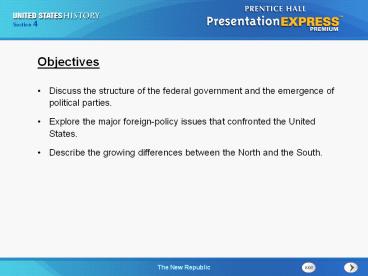PresentationExpress - PowerPoint PPT Presentation
1 / 19
Title:
PresentationExpress
Description:
Discuss the structure of the federal government and the emergence of political parties. Explore the major foreign-policy issues that confronted the United States. – PowerPoint PPT presentation
Number of Views:125
Avg rating:3.0/5.0
Title: PresentationExpress
1
Objectives
- Discuss the structure of the federal government
and the emergence of political parties. - Explore the major foreign-policy issues that
confronted the United States. - Describe the growing differences between the
North and the South.
2
Terms and People
- Alien Act - Federalist law meant to make it more
difficult for immigrants to become citizens - Sedition Act - Federalist law meant to stop
criticism of President Adamss policies by
Democratic Republicans - judicial review - power of the court to declare
an act of Congress or the President
unconstitutional - Louisiana Purchase - large territory purchased
from France in 1803, doubling the size of the U.S.
3
Terms and People (Continued)
- impressment - British practice of pressing or
forcing American sailors into the British navy - embargo - suspension of trade
- cotton gin - invention by Eli Whitney to separate
cotton fibers from shells, made slavery more
profitable in the South - Monroe Doctrine - U.S. policy barring European
interference in the Americas
4
How did the United States and its government
change in the late 1700s and early 1800s?
Both internal political issues and international
affairs tested the new nation. Despite these
challenges, the United States grew. But with
growth came economic, political, and social
issues that began to divide the North and the
South.
5
In 1789, George Washington took office as the
first President of the United States.
Left to right Washington, Adams, and Jefferson
6
The future of the nation depended onhis ability
to lead.
Washington proved an excellent choice. He
selected a skilled Cabinet, includingAlexander
Hamilton and Thomas Jefferson.
Hamilton proposed an economic plan that included
a national bank.
7
Opponents criticized Hamiltons broad
interpretation of the Constitution.
Federalists believed the Constitution empowered
Congress to enact laws for the general welfare.
They were loose constructionists.
Democratic Republicans wanted to limit the
federal government only to powers stated in the
Constitution. They were strict constructionists.
8
American loyalties were split bythe French
Revolution and the resulting war between France
and Britain.
- Democratic Republicans sympathized with the
French, while Federalists favored Britain. - Despite U.S. neutrality, American ships were
seized by the British for trading with the
French. - In 1794 Washington sent John Jay to negotiate
with Britain. - Jays Treaty avoided war but the Democratic
Republicans cried foul.
9
- American ships were seized.
- French officials demanded bribes.
- Full-scale naval war erupted.
In 1796 John Adams was elected the second
President.He faced challenges from France.
10
The Federalists exploited the crisis by passing
two laws aimed at their opponents.
- The Alien Act allowed the deportation of
pro-French immigrants who criticized the
government. - The Sedition Act made it a crime to publicly
discredit Federal leaders. - Unpopular laws led to the decline of the
Federalists.
11
Thomas Jefferson defeated Adams in the election
of 1800.
- The election set a precedent for the peaceful
transfer of power based on voting. - Jefferson and the Democratic Republicans
eliminated unpopular taxes, cut expenses,and
reduced the national debt.
12
In Marbury v. Madison the Supreme Court asserted
judicial review, the power to decide the
constitutionality of acts of Congress or the
President.
Jeffersons policies to limit federal power,
however, were checked by Chief Justice John
Marshall.
13
In 1803 Jefferson obtained the huge Louisiana
Purchase from French ruler Napoleon Bonaparte.
Meriwether Lewis and William Clarkexplored the
new territory.
14
- Jefferson persuaded Congress to declare a trade
embargo. - He hoped the lack of trade would hurt Britain. It
hurt Americans more. - The unsuccessful embargo was lifted in 1809.
Britain resumed seizing U.S. ships trading with
France and allowed for the impressment of U.S.
sailors.
15
In 1809, Democratic Republican James Madison
succeeded Jefferson as President.
- In 1812 the United States went to war with
Britain. - The Americans failed to take Canada and the
British burned Washington, D.C. - The war ended with an 1814 peace treaty.
16
Northerners built factories during the War of
1812. These attracted European immigrants and
promoted urban growth.
War set the North on a different path from the
South
17
Southern states remained agricultural and
dependent on enslaved labor.
- Eli Whitneys invention of the cotton gin made
slavery more profitable for southern planters. - Plantations expanded-and forced more slaves to
work-to provide cotton for northern textile
mills.
18
- It stated European monarchies had no business
meddling with American republics. - The United States, similarly, would stay out of
European affairs.
In 1823, PresidentJames Monroeissued the
MonroeDoctrine.
19
Section Review
Know It, Show It Quiz
QuickTake Quiz

